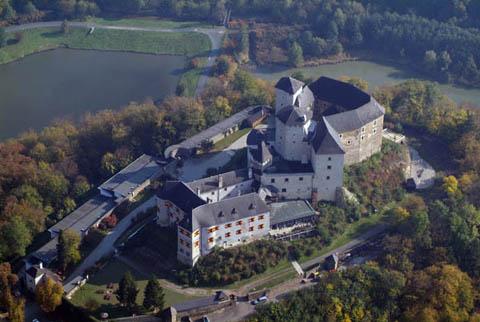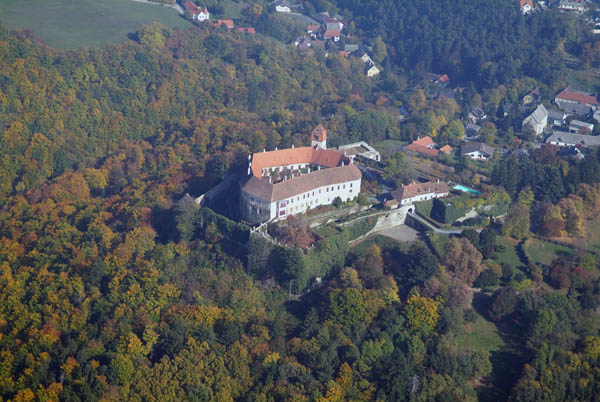Around 1157, a small wooden fort is said to have been built by Count Wolfer, and it is thought though that the first occupants were the Benedictines. The name of "Our Holy Mary of Snow" as the chapel are mentioned in documents dating back to this time, which would indicate that there was at least a crude abbey or monastery at the site. Ownership of the structure later passed to King Béla III, who strengthened the original wooden structure with stone walls. Since 1198, Güssing became known as "Novum Castrum".1246 king Béla IV for a brief period of time entrusted the castle to the Order of Saint John (1246) and later to his treasurer Mauricius (1263).
In 1272 Heinrich II from the dynasty of the "Counts of Güssing" and a descendant of Count Wolfer regained ownership of Güssing. Evidently the family though had been involved in several wars against the royal dynasties. They conducted wild raids and were the cause of widespread unrest in the area. Finally, in 1289/90 Duke Albrecht deprived the counts of Güssing of their power with the permission of Ladislaus IV.
Under Emperor Sigismund the castle went to the dynasty of Cseh de Sáró and Léva in 1391. However, their descendants acquired such heavy debt that all their assets had to be mortgaged and in 1458 Nikolaus Újlaki became owner of the castle and ruler of Güssing.
In 1459 those Magnates who were not satisfied with the election of Matthias Corvinus, had crowned Emperor Frederick III to King of Hungary at the castle of Güssing. This remained without success and in the end Újlaki had to pay homage to King Corvinus. Újlak's son Lorenz, as loyal follower of King Matthias, forcefully and publicly appeared against his successor the bohemian King Vladislav II resulting in strife and warfare between the rival kingships. In 1495 the castle was heavily damaged by the King's forces, forcing Ujlaki to reconcile with the King Corvinius. Four years later Ujlaki died childless, putting an end to any claims of kingship from his line.
Finally, on June 30, 1524, Francis I, Batthyány (1497 – 1566) received Castle Güssing, consisting of dominion over 60 villages, from his friend King Ludwig II. This was a reward for Francis’ heroic defence of the fortress of Jaicza against the Turks. From that time on Güssing became the main residence and ancestral home of the Batthyánys. Gradually, Güssing was enlarged from a small stone castle and monastery to a proper fortress with which the Batthyánys hoped to defend against the Turks. Indeed, when the Turks passed through Güssing on their way to Vienna for war, they wreaked havoc on the town. In order to prevent the complete annihilation of the community, Franz I aligned himself with the Turkish forces.
From then on the fortress was enforced for 75,000 florins and under Balthasar III, Franz II and Adam I the fortress of Güssing was enlarged considerably. Between the years of 1540 and 1580 the “round tower” and fortified bastion was built. Because of the imminent danger of attack posed by the marauding Turks, the Batthyánys had to maintain a constant garrison at each of their castle, causing a significant strain on the treasury. Between the 16th and 17th century, it is estimated that 3000 people may have found shelter at the castle.
Under Francis II, the Turks (part of the “Bocskay uprising”) again invaded Güssing and devastated the country.
In 1638, Adam I brought the Franciscans to Güssing and founded the monastery with the family’s burial place and tomb. Adam I also further promoted Güssing to a place of education for young aristocrats from all over Europe.
In 1683 under Christoph II, the castle provided shelter for Güssing’s inhabitants to flee the approaching Turks, who passed through after their occupation of Vienna. Christoph and his son Adam II pursued the Turks and engaged in their running fight. In 1700 the castle served as an Arsenal for the imperial troops.
Times changed and due to the modernization of warfare, the castle and fortress of Güssing slowly lost its strategic importance. In 1777 all guns were removed. Due to the high cost of maintenance and the introduced “roof tax” by empress Maria Theresia, there was a partial demolition of some of the castles fortifications.
Since the separation into the "Christoph’s line" (older/princely line) and the "Paul’s line" (younger line) after Adam’s I death in 1659, but at the latest since Prince Louie Batthyány-Strattmann in 1787 made Körmend his main residence and center of administration. Güssing had lost its character as the center of power for the Batthyánys.
In 1870 Prince Philipp Batthyány-Strattmann established a foundation for the preservation of the castle and monastery as an historic structure. However, in the years following World War I, foundation had lost most of its money due to inflation and the costs of war. In the 1980s the Batthyánys offered the public authorities/Land Burgenland the possibility to participate in the management of the Prince Batthyány foundation. The castle continues to be managed by the Prince Philipp Batthyány-Strattmann foundation. Its trustee is the respective chef de famille, currently the 9th Prince, Ladislaus Pascal Batthyány Strattmann who together with an administrator of the government of Burgenland manages the foundation.














